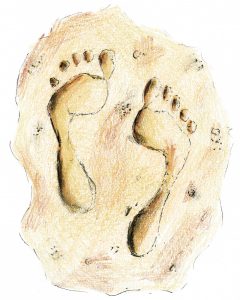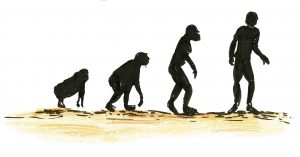
Author: Layal Bou Abdo MSN
Illustration: Angeline Boswell
There is fossil evidence that suggests our ancestors have been walking upright for at least six million years. Those fossils were the most suggestive of our evolutionary past. They were found in the bed of a dried-up river in the north of Tanzania. Pressed into hardened volcanic ash, were found 3 footprints of early humans. Those footprints go back to 3.66 million years ago, a long time before our own species of human, Homo Sapiens existed. Footprints are the earliest indisputable evidence that our distant ancestors had shifted from four legs to two, becoming “bipeds“. Scientists do not exactly know why we became bipeds and why humankind abandoned life on all fours. However, they all agreed that permanently standing up opened up new opportunities for our ancestors to touch, explore, pick up, throw and learn.
Scientists think that our early human predecessors sometime between 13 million and six million years ago lived high in the trees. Those trees are thought to have covered much of Africa at the time.

Footprints Fossil
How and why did these changes occur?
Scientists believe that those changes happened due to climate change.
Many years ago, Africa began to lose some of its forests and vast grasslands grew. Our ancestors left forests and moved out onto savannahs and patches of woodland. The new habitat required the tree-climbers to become more adept at walking on land. In an environment with fewer trees, standing up was essential to allow our ancestors to see over long grass so they can hunt and later. Later, they shifted their hunting strategies to throw weapons so they can take bigger and fast-moving prey. They also needed to carry what they hunted to their habitat.
Moreover, the hot weather in Africa forced our ancestors to walk on two legs, reducing the body surface exposed to the sun and raises the body away from the hot ground. Standing up exposes the body to greater wind flows keeping us cool.
What happened to the human body during the transformation into bipeds?
Our ancestors went through many body modifications to shift from four legs to two:
- The pelvis shortened, the thighs became longer, the angle of the thigh bone changed to point inwards allowing the knees to come together under our center of gravity! This allows us to stand for a long period without getting tired.
- The spine curved into an S-shape helping to support the head and creating balance.
- Our legs grow longer, our feet get shorter and our toes lined up with one another.
- We lost our body hair.
- We developed the right muscles and the right skeletal system to facilitate walking on two legs. And, that gave us a very different profile from the quadrupeds we left behind.

Humans evolution
Advantages of being bipeds
- Walking upright freed the hands for carrying and manipulating tools, stretch for fruit in trees and use their hands for social display and communication.
- Allows long-distance walking, endurance running and navigation.
- It may have been a key step that led our ancestors’ brains to grow.
- Walking is also more energy-efficient, and it’s easier to do a lot of things if you aren’t stepping on your own hands.
- It improves our ability to cool-off while reducing energy costs associated with moving about.
- It enabled early humans to appear larger and more intimidating.
Disadvantages of being bipeds
- After moving from quadrupeds to being bipeds, more pressure was put on our spine. The vertical position of the spine makes it more prone to back injuries and problems.
- Bipedalism put also pressure on our joints (knees).
- It’s much harder on the heart and its vessels to pump blood to the entire body organs. That’s one reason why some people get varicose veins*. The veins extend because the heart doesn’t have the pressure that it needs to pump the blood all the way back up.
Fun Facts
- Did you know that we still carry some traits from the tree-dwelling past? Have you ever noticed what will happen to the baby’s tiny fingers when you place your finger under his toes or fingers (on his palm)? They will curl those digits around it to get a grip. In the trees, infant primates cling to their mothers and branches from birth. If they do not, they will fall and die.
- Did you know that Humans walking on two legs consume only a quarter of the energy that chimpanzees use while “knuckle-walking” on all fours?
Reflexion
We became bipedal due to climate changes what will happen to humankind with the current global warming?
Environmental conditions may have stimulated important developments in human origins and we are sure that it will influence human evolution.
*What are varicose veins?
They are blue or purple twisted on the legs of grown-ups. They look like lines on a roadmap and they are raised. Our veins a full of valves that help keep the blood flowing in the right direction. Those valves are like tiny doors that close and open in one direction allowing the blood to pass through making sure it doesn’t flow back. As we get older, the valve might not work well. when this happens, some blood might be retained in the veins. Moreover, gravity might make things worst with long hours of standing. This makes the veins swell. That swollen vein is a varicose vein.
We are certain your kid asks you health (human & animal) questions that genuinely leave you stumped! Leave a comment below and we are happy to answer “why” in future blogs.
Copyright © 2020 Little Medical School Ottawa

I had learned that climate change ultimately caused early humans to live by the water. The water was where their food was, so having fur was a hindrance, slowing swimming hunters down. Standing in the water frees one’s hands as well as preventing water inhalation. Eventually man lost his “fur” and developed a water friendly streamline body. Millenniums by the water also produced the balding patterns in men.
Great comment, thanks for sharing.
This was an enlightening article. Thank you. I also love the layout of the article
Thanks, Mercy! We are glad you enjoyed reading it.
I think that this article was super DUPER helpful for my knowledge? Thank you so much for providing it I love this so muuuuuuuuch?
Thank you so much for your feedback, we are glad that you enjoyed reading it.
i love your article, but when it comes to the creation of humans, i believe in God who created us and the whole earth. scientists are very good in what they are doing and i respect that.. but you cannot tell me any different in what i believe. just a little joke nothing serious: 4 scientists went in front of
God and told him we know how you created humans. God said o.k.. show me. so they got their shovels an start digging in the dirt.. so God said, wait a minute make your own dirt.
Thank you for your thoughtful comment! I’m glad you enjoyed the article. Beliefs about the creation of humans vary, and it’s wonderful that we can appreciate different perspectives. Your joke is a lighthearted way to highlight the diversity in beliefs. It’s always interesting to find humor in our interpretations of the world. If you have any more thoughts or questions, feel free to share!
[…] Nov 18, 2023 #2 legs, #4 legs, #ape, #bird, #evolution, #human, #kangaroo https://littlemedicalschool.com/ottawa/blog/why-do-we-walk-on-two-legs/ […]
Thank ou for your question. Bipedalism, or the utilization of two legs for movement, is not commonly seen in the animal world. This can be attributed to evolutionary adaptations that prioritize specialized limbs, conserve energy, and provide functional advantages in various habitats. The majority of animals have evolved to be quadrupeds or have developed distinct appendages for particular functions, such as flying, swimming, and climbing. The prevalence of quadrupedalism is due to its benefits of stability, speed, and efficient energy consumption. Furthermore, the dynamics of predator-prey interactions and environmental considerations play a role in determining an animal’s chosen method of locomotion. Although bipedalism has proven to be advantageous for certain species of birds and humans, it remains a specialized form of movement confined to specific ecological environments.
Little Medical School’s recognition in “10 Emerging Franchises Primed for Growth in 2021” by 1851franchise.com is a testament to our innovative healthcare education concept for kids. We’re not just reveling in the acknowledgment; we’re using it as a springboard for expansion and success. Join our winning team – a proven business model, strategic marketing, and robust franchisee support. We’re not just a brand; we’re a journey of perpetual innovation, redefining children’s education. Little Medical School: where innovation meets inspiration.
https://littlemedicalschool.com/franchise-opportunities/